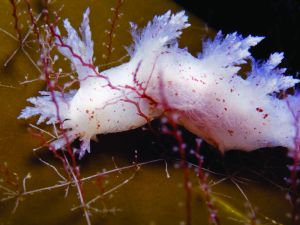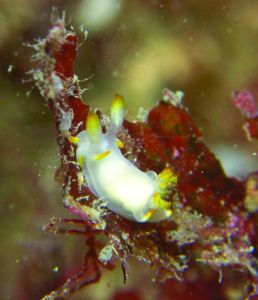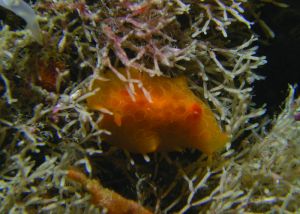For a variety of reasons it has been a quiet year on the marine recording front. To start with, a number of regular record contributors were out of action, and to all those who were prevented from getting out into the field I wish them better luck in 2009. I include myself in this, having experienced the great inconvenience of a broken wrist! Nevertheless the absence of a few key people does highlight an increasing problem the Society has with recording, at least on the marine side. When I took over the post as Recorder in 1991, the membership of the Society stood at 460 and there were more members in the Society who were actively recording marine molluscs. Coupled with this, there has been a decline in the number of marine field meetings and attendance has also waned. Both these factors feed back into the recording schemes, although records from individual field work and a certain amount of academic and contractual survey activity have always formed an important part of the spectrum of sources of records made available to the Society’s recording scheme.
Early in January a rather interesting find was made by Steve Trewhella, a Dorset man with a strong involvement in local marine conservation issues and activities, who regularly walks stretches of the Dorset coast in search of unusual flotsam and strandings. He found an item, which forms the basis of a separate article in this issue, in the form of a broken plastic fish box at Chesil Cove. This was to yield three species of sea slug, including the rare Hancockia uncinata, and a bivalve species, Pseudochama gryphina, which I believe to be new to the list for the British Isles and possibly northwest Europe (see page 17 in this issue). Julia Nunn lists new records for Ireland, (see figure 1), and singles out Pholadidea loscombiana as noteworthy. Several live animals were found in sandstone at a site on the east Antrim coast, this being a first sighting for the whole of Ireland since its original record at the turn of the 19th century.
Fig 1 New records for Ireland submitted by Julia Nunn
| Area | Record | Species | Area | Year | Recorder |
| 28 | NEW | Favorinus branchialis | Strangford Lough | 2008 | Julia Nunn |
| 28 | post-1950 | Pholadidea loscombiana | Straidkilly | 2008 | Julia Nunn |
| 29A | NEW | Partulida spiralis | Ballycastle | 2008 | Julia Nunn |
| 29A | NEW | Hermaea bifida | Rinagree | 2008 | Julia Nunn |
| 33 | NEW | Aeolidiella sanguinea | The Hassans | 2008 | Bernard Picton |
| 34 | post-1990 | Aeolidiella glauca | Mulroy Murles Point | 2008 | Julia Nunn |
There are more new marine records to come from Ireland, resulting from work that was carried out as part of the Sublittoral Survey Northern Ireland which was a partnership between the Northern Ireland Environment Agency and National Museums Northern Ireland (Ulster Museum). The two year project (2006-2008) aimed to gain information on the current status of Northern Ireland Priority Species. Much of the Northern Ireland coast was last surveyed during the Northern Ireland Sublittoral Survey (1982-86) and consequently there was very little recent information on these species. Five key areas were targeted: Rathlin Island, The Skerries, Strangford Lough, Carlingford Lough and the Maidens. Sixty-five post-1990 or new records have been collated. Of these the following are particularly noteworthy:
Fig 2 Additional new records from Ireland from Sublittoral Survey Northern Ireland
| Sea Area | Record | Species | Area | Year | Recorder |
| 28 | NEW | Caloria elegans | Maidens | 2006 | Bernard Picton & Jen Jones |
| 28 | NEW | Cuthona rubescens | Strangford Lough | 2006 | Bernard Picton |
| 28 | NEW | Doto tuberculata | Maidens | 2007 | Bernard Picton |
| 28 | NEW | Okenia elegans | Strangford Lough | 2007 | Colin Ferguson |
| 28 | NEW | Onchidoris depressa | Maidens | 2006 | Bernard Picton |
| 29A | NEW | Aegires punctilucens | Skerries | 2006 | Claire Goodwin |
| 29A | NEW | Cuthona caerulea | Skerries | 2006 | Bernard Picton |
| 29A | NEW | Doto hydrallmaniae | Skerries | 2006 | Bernard Picton |
| 29A | NEW | Doto hystrix | Rathlin | 2006 | Bernard Picton |
| 29A | NEW Ireland | Doto sarsiae | Rathlin | 2007 | Bernard Picton |
| 29A | NEW | Eubranchus vittatus | Rathlin | 2007 | Claire Goodwin |
| 29A | NEW | Flabellina pellucida | Rathlin | 2006 | Bernard Picton |
| 29A | NEW | Lutraria lutraria | Skerries | 2006 | Claire Goodwin |
| 29A | NEW | Okenia pulchella | Rathlin | 2007 | Claire Goodwin |
| 29A | NEW | Philine pruinosa | Cushendun | 2006 | Claire Goodwin |
Doris ocelligera was found in May 2004 living in Lyme Bay, Dorset during the Society’s joint meeting with Porcupine Marine Natural History Society. The first specimen was obtained by dredge by Celia Pain, and the remaining two by diving by Lin Baldock. D. ocelligera is pale yellow all over, with very spiculose tubercules, each tipped with a conspicuous brown mark. These three animals were identified by Julia Nunn, confirmed by Bernard Picton. They are the first records for the British Isles. Julia is writing this record up as a note for the Society’s Journal.
On 2nd April, Terry Wimbleton reported a mature live individual of Mya arenaria on the shore at Langstone Bridge, Langstone Harbour, Havant. The species was hit hard in the severe winter of 1962-63 and according to Terry, who has recorded regularly over many years on Hampshire shores, had not been recorded as a live sighting since.
Hancockia uncinata features again in this report with the first record for Scotland made by Jim Anderson in September 2008. He found the species in the Sound of Mull, and according to Bernard Picton who confirmed the identification, early autumn is the time to record the species, certainly from Bernard’s experience in Ireland. Jim Anderson is a diver who has a special affinity for nudibranchs. He has passed all his records for 2008 to the Society for incorporation into its database, which I gratefully acknowledge, and his stunning picture gallery can be viewed at www.scottishnudibranchs.co.uk In addition to Hancockia, Jim recorded two other nudibranchs which represent new records. Dendronotus lacteus (Thompson, 1840), a taxon subsequently synonymised with its congener D. frondosus, was reinstated by Mikael Thollesson in 1998 on the basis of the results of allozyme electrophoresis. Anderson first found the species on the west Scottish coast in 2002, and two sites in his 2008 data have now brought the species to my attention. I thank Jim for allowing the use of his image of the species, characterised by its opaque white colour with dark purpleblackish blotches in contrast to D. frondosus which is brown, Figure 3.
 |
Figure 3: Dendronotus lacteus from West Scotland (photo Jim Anderson) |
There are two additional nudibranchs which are new to the British Isles. David and Sarah Kipling found and reported to the Sea Slug Forum a species which was identified by Bernard Picton as Trapania tartanella. It was found on a wreck near the Manacles in Cornwall in September 2007. Bernard had seen the species in northwest Spain and Portugal, but no further north and I thank David for allowing the use of his image to accompany this report, Figure 4.
 |
Figure 4: Trapania tartanella from Cornwall (photo David Kipling) |
During a Seasearch survey in October 2008 Mark Warren observed an unfamiliar sea slug which was identified as Discodoris rosi, Figure 5. Found in 20m of water off St Mary’s in Scilly this species had not been recorded further north than the north coast of Brittany. As it is a large and conspicuous species (the Scilly individual was 25cm in length) Bernard Picton believes the find may represent a true range extension. Another diver observed another individual in the vicinity which suggests a population may have established itself at the site. Bernard goes on to say, ‘The Scilly Isles are probably one of the places we can expect species crossing the English Channel to be seen first, if global warming continues to affect the North Atlantic by warming. It was first described from Galicia, NW Spain as recently as 1979, indeed I saw it there myself in 1978. At the time I identified the sponge it was feeding on as Microciona strepsitoxa, a red encrusting sponge on which it is reasonably well camouflaged. Since then it has been reported from a few scattered sites throughout the Mediterranean Sea and here on the Sea Slug Forum as far north as Belle-Ile in Southern Brittany. The sponge seems to have a more northerly distribution in Britain and Ireland, so perhaps that made it possible for the nudibranch larvae to get started once they had somehow crossed the English Channel.’
 |
Figure 5: Discodoris rosi off St Mary’s, Scilly (photo Mark Warren) |
At the beginning of this report I lamented the paucity of records for 2008 and what I perceive to be a declining level of marine recording activity in the Society. This can only partially be addressed by the membership. At the time of compiling this report, a draft Data Sharing Agreement has been drawn up by Julia Nunn for consideration and circulation to Council. There are numerous biological recording centres (LRCs, Wildlife Trusts and MarLIN for example) as well as other webbased bulletin boards and recording fora, and it is evident that many records are going to these ‘reservoirs’ in the first instance. I regard it as a matter of high priority that the Society now engages with the wider recording community and approaches these external agencies in order to set in motion a reciprocal process of data exchange, in order to build up our recording scheme as the prime source of marine mollusc records for the United Kingdom. It is to be hoped that the Recording Manual, due to be published later this year, will act as a stimulus and a resource for those people both within the Conchological Society and outside it who are collecting marine mollusc data. I thank all those who submitted material for inclusion in this report. All the records mentioned are new information to the Society’s Marine Census.
